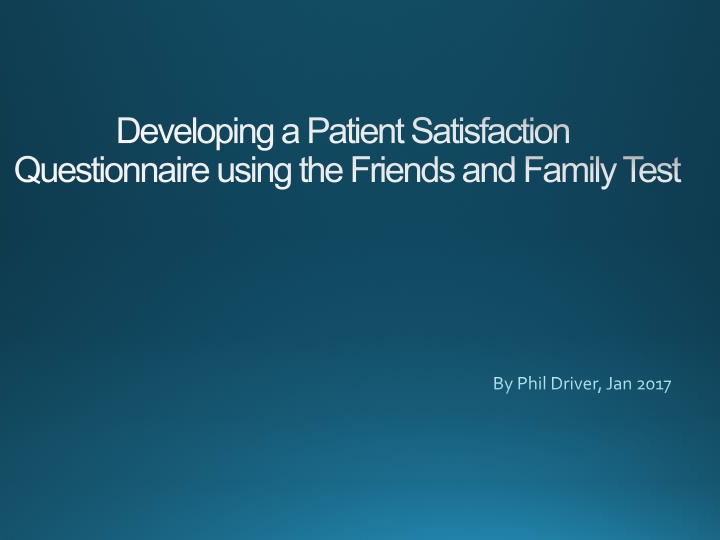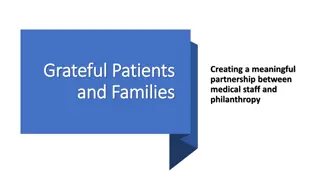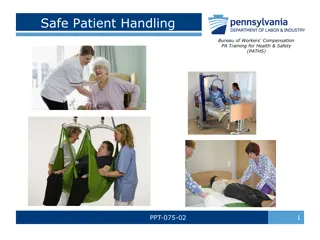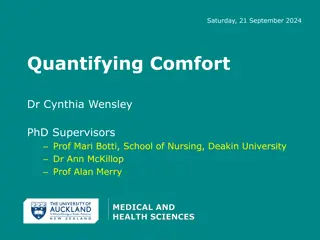Enhancing Patient Experience: The Friends and Family Test in Healthcare
Patient experience plays a crucial role in healthcare settings, impacting safety, clinical effectiveness, and overall outcomes. The Friends and Family Test (FFT) based on the Net Promoter Score is a valuable tool to measure customer loyalty and satisfaction. By focusing on direct feedback from patients, the NHS aims to prioritize patient-centered care and drive cultural change within the healthcare system. Understanding the correlation between patient satisfaction and various health indicators can strengthen service delivery and enhance overall quality of care.
Download Presentation

Please find below an Image/Link to download the presentation.
The content on the website is provided AS IS for your information and personal use only. It may not be sold, licensed, or shared on other websites without obtaining consent from the author.If you encounter any issues during the download, it is possible that the publisher has removed the file from their server.
You are allowed to download the files provided on this website for personal or commercial use, subject to the condition that they are used lawfully. All files are the property of their respective owners.
The content on the website is provided AS IS for your information and personal use only. It may not be sold, licensed, or shared on other websites without obtaining consent from the author.
E N D
Presentation Transcript
Developing a Patient Satisfaction Questionnaire using the Friends and Family Test By Phil Driver, Jan 2017
Why patient experience? The Francis Report Huge effect on how all services in the NHS are assessed, monitored and commissioned. Recommended a fundamental cultural change in the NHS, putting the patients at the centre of care. Putting Patients First NHS England business plan for 2013/14-2015/16 was produced to support this change and guide commissioners: 11 core priorities; patient satisfaction established through direct feedback from patients and families were given precedence along with direct feedback from staff 2016/17 plan 10 core priorities; patient experience within specific patient groups eg cancer, mental health, learning difficulties.
CCG and Patient Experience What influences CCG commissioning?: NHS Outcome framework (14/15 & 15/16) -5 domains / 3 pillars: Prevention, Enhancing quality of life, Recovery - EFFECTIVENESS Patient Experience - EXPERIENCE Safe environment -SAFETY
Patient experience the evidence Doyle et al., (2014) systematic review: Patient experienceis consistently positively associated with patient safety and clinical effectiveness. Patient experience is positively associated with health outcomes. Satisfaction-compliance link (Williams, 1994); compliance with appointment keeping and adhering to recommended treatment is dependent on patient satisfaction. Therefore, a better understanding of what effects patients satisfaction arguably strengthens our services ability to effect patient safety, clinical effectiveness, DNA rates, compliance and health outcomes.
So whats new? Satisfaction surveys to establish direct feedback from patients are not new. However, the methodology has often been inconsistent between Trusts and outcomes have not been synthesised or reported in real time. To allow easy comparison between trusts, hospitals and departments, a simple but standardised performance metric was deemed necessary.
The Friends and Family Test (FFT) The FFT is based on a Net Promoter Score (NPS) designed to measure customer loyalty (Reichheld, 2003) and responses are marked on a 5-point Likert scale. Reichheld argued that the concept of recommendation was easier to understand for the general public rather than the abstract construct of satisfaction . The FFT (Cain, 2013) asks: How likely are you to recommend our ward / A+E department to friends and family if they needed similar care or treatment?
FFT has now been rolled out to most of the NHS including primary care The FFT has produced around 25 million pieces of feedback so far and the total rises by over a million a month
Therefore .. We must demonstrate patient satisfaction with our service to satisfy NHS Outcome Framework and therefore provide clear comparative information to support CCG and Health and Well being boards commission and monitor services. The FFT must be used to establish this. On its own, the FFT does not provide us with the information from our patient group to make informed decisions about appropriate changes to the care we provided in order to improve patient experience.
Follow up Questions Follow up questions should relate to the most important domains of patient experience for the local population in order to inform local quality improvement. It is up to the individual organisations to decide how they wish to gain insight into the drivers of satisfaction.
Research: Satisfaction in physiotherapy If follow up questions should relate to the most important domains of patient experience for the local population it seems logical to involve patients to help define the underlying drivers and themes for the follow up questions. Unfortunately, the majority of these tools were designed for private health economy settings, and therefore placed significant emphasis on cost, location and selection of care provider.
It has become apparent that relatively few authors developing tools for the physiotherapy setting have used a qualitative approach to gain such an insight into patient experience of physiotherapy. An exception to this was the work by Hills (2003) and Hills and Kitchen (2007a -d) who developed a new tool to measure satisfaction within NHS outpatient physiotherapy for patients with musculoskeletal disorders. They used individual unstructured and semi-structured interviews and focus groups to establish principle themes that were of primary importance to this specific patient group.
Hills and Kitchen Questionnaire The questionnaire comprises six subscales; Patient Satisfaction Expectations Communication Perception of Therapist Organisation Outcome Demonstrated good levels of reliability (alpha >0.8)
New Questionnaire FFT alone mandatory but not enough. H+K questionnaire specific to our patient population but no FFT Therefore, combining statements from H+K in subscales of Expectations, Communication, Perception of Therapist, Organisation and Outcome with the FFT in place of statements of overall satisfaction addresses patient satisfaction in the most comprehensive way.
Method Pilot study 30 questionnaires from 3 sites Correction of data collection processes 1 question remove due to poor completion Reliability Chronbach s alpha 0.924 Final questionnaire consisted of FFT and 30 follow up questions. Demographic questions at the end. Main study 450 questionnaires collected from all 9 ELHT physiotherapy outpatient sites.
Analysis Mean score for each variable calculated. Spearman s rank correlation coefficient calculated between the 5 independent variable and FFT to establish strength and direction of relationship. Multiple regression coefficient was calculated to establish model of best fit and determine how well this model could predict one variable from another. Spearman s correlation coefficient was recalculated for relationship between the FFT and each individual follow up statements
Demographics Subject Characteristic N % Gender Male 184 41.6 Female 258 58.4 Age 18-29 30-39 48 42 10.9 9.5 40-49 85 19.2 50-59 95 21.5 60-69 103 23.3 70-79 59 13.3 80-89 9 2 Over 90 1 0.2 Body Site Spine 156 35.3 Upper Limb 117 26.5 Lower Limb 140 31.7 Other 29 6.6
Mean scores of subgroups Therapist FFT Communication Organisation Expectation Outcome N 450 450 450 450 450 450 Mean 4.78 4.56 4.56 4.32 4.11 3.52 Std. Deviation .501 .422 .497 .521 .635 .794 Perception of Therapist and Communication produced the highest mean scores with the smallest standard deviation. Outcome produced the lowest mean score with the largest standard deviation. Ranked order was identical to H&K (2007)
Correlation Variable FFT Expectation Therapist Communicatio n Organisation Outcome FFT 1.00 Expectation .255 1.00 Perception of Therapist .400 .379 1.00 Communication .412 .379 .686 1.00 Organisation .429 .416 .589 .669 1.00 Outcome .277 .607 .349 .362 .424 1.00 The correlation between the six subscales achieved statistical significance at 0.01 level (one-tailed) The highest correlation was between Communication and Therapist (0.686) and between Communication and Organisation (0.669). Ranked correlation with FFT; Organisation, Communication, Therapist, Outcome and Expectation.
Regression Variable Beta T p Dependent variable = FFT Organisation Perception of Therapist Communication Expectation Outcome .213 .153 .133 .011 .079 3.525 2.540 2.043 .196 1.456 .000 .011 .042 .844 .146 Organisation, Therapist and communication made a statistically unique contribution to the FFT (Ranked Organisation, Therapist and communication) Expectation and Outcome scores did not make a significantly unique contribution to FFT (p<0.05)
Individual questions Rank Question Spearman s Rho 1 2 3 4 5 6 7 8 9 10 11 12 13 14 15 16 17 18 19 20 21 22 23 24 25 26 27 28 29 30 My therapist gave me the confidence that I was going to get better. The treatment has not helped me at all. The treatment was fully explained to me The treatment sessions were too short. The therapist did not answer all my questions. My therapist gave me encouragement and praise. The therapist explained my condition to me in great detail. My therapist did not listen to what I had to say. My therapist put me at ease and was very kind to me. Treatment sessions were too infrequent to get any benefit. My therapist did not seem interested in me. I was not always seen promptly for my treatment sessions. I did not have the undivided attention of the therapist during my treatment. I was able to ask the therapist about anything connected with my treatment. I was made aware of my responsibilities in managing my condition as a result of treatment. The treatment was too rushed. I did not have confidence at the therapist knew what s(he) was doing I have regained full mobility as a result of my treatment I was able to contact the department for help if I had any problems. I got on very well with my therapist. It was important for me to see the same therapist throughout my treatment I did not think that treatment would be able to help me. I have made a full recovery as a result of treatment. I am now completely pain free as a result of my treatment I did not have any of my treatment sessions cancelled The treatment helped at the time but the effects did not last. I expected the treatment would help relieve my pain. I expected the treatment would cure my problem. I expected the treatment would get me better. The treatment has helped me in some ways but I am not completely better. .429 .378 .366 .366 .362 .358 .347 .344 .343 .336 .321 .318 .316 .301 .296 .293 .283 .278 .259 .259 .233 .232 .229 .215 .199 .190 .165 .163 .146 .021
Discussion Overall satisfaction using the FFT: Likert score = 4.8 FFT = 80 How does this compare? H+K = 3.82 using a subgroup of questions Meta-analysis (7 studies of MSK Physio) = 4.4 (Hush et al., 2011) Mean FFT for ELHT (IP & A+E) = 70
High overall satisfaction It would appear that overall satisfaction for the ELHT physiotherapy service was recorded more positively than comparative research and within the Trust s own FFT scores. However, it is possible that the FFT is a less accurate measure of satisfaction: Schnider et al. (2008) Greaves et al. (2013) Graham & MacCormick (2012) DNA patients: Unlike current collection of FFT for inpatients, this study relied on patients completing their episode of care for their experience to be evaluated. Patients that DNA could simply reflect that patients feel they have achieved sufficient benefit. However, could also support that those that DNA are less satisfied ie compliance is dependent on satisfaction (Willams, 1994).
Domains of care and their influence on satisfaction Perception of and communication with the therapist Highest mean scores Intimately linked, supported by the highest correlation between these 2 subgroups. Suggests that patents felt able to openly communicate with their therapist and subsequently establish a relationship with them. Relational aspects of care treated as individual, listened to, asked Q s, involved in decision making. Organisation Strongest predictor and correlation with overall satisfaction. Elements such as frequency and duration of appointments and punctuality are clearly important factors. A well organised service conceivably provides the appropriate framework for effective communication and patient-therapist interaction.
Outcome Small correlation with FFT and did not have a statistically significant effect on prediction. Outcome questions focused on pain and function, however, clinical outcome is a multidimensional paradigm that not only reports physical outcome, but emotional well-being also. Patients do not always achieve full symptomatic relief but can still be satisfied. Indirect influence over emotional management may enhance well-being, lessen anxiety and provide comfort. Physiotherapists may have greater effect over emotional management Mean score was still greater than 3 indicating that patients were satisfied or very satisfied with their outcome.
Expectations Unable to significantly predict patient satisfaction in the regression analysis. The expectation items used were confined to the patient s perceived clinical outcome and therefore provide a narrow scope of an individual s expectations regarding use of physiotherapy services. As already discussed, clinical outcome may not be as important to a patient as the interactions they have with professionals during their service use. It is not surprising therefore, that expectation of an aspect of care that appears to have little influence over satisfaction is a poor predictor of satisfaction.
Conclusion Using the FFT as a measure of overall satisfaction, very high levels of satisfaction for this sample of physiotherapy MSK Outpatients has been demonstrated. This is a key selling point to commissioners who are expected to commission care from organisation that improve the quality of patient experience. The FFT has performed in a similar way to a group of questions exploring the concept of overall satisfaction, but demonstrates weaker correlation and predictability. Appropriate analysis has successfully been used to determine which aspects of the patient experience influence overall satisfaction. This has enabled the author to make informed recommendations to maintain and improve patient satisfaction
Recommendations Feedback to staff - highlight the importance of good communication and appropriate patient interaction with emphasis on patient education, self- management advice and empathetic care. Organisational elements such as punctuality, cancellation of appointments and frequency of appointments strongly influence patient satisfaction Any reduction in appointment duration should be closely monitored. Direct comparison of satisfaction between shortened appointments and current duration should be performed to establish any effect on patient satisfaction. By examining the ranked order of relationship between individual questions and the FFT, a selection of the most influential follow up questions could be used to produce a condensed version of the questionnaire. Further work to establish the reliability and validity of this condensed version would need to be done.
It should be recognised that clinical outcome not only reports physical outcome, but also emotional well-being. Therefore, although physical clinical outcome remains an important indicator of effectiveness, it should arguably be evaluated in the context of optimising clinical management, rather than patient satisfaction.























